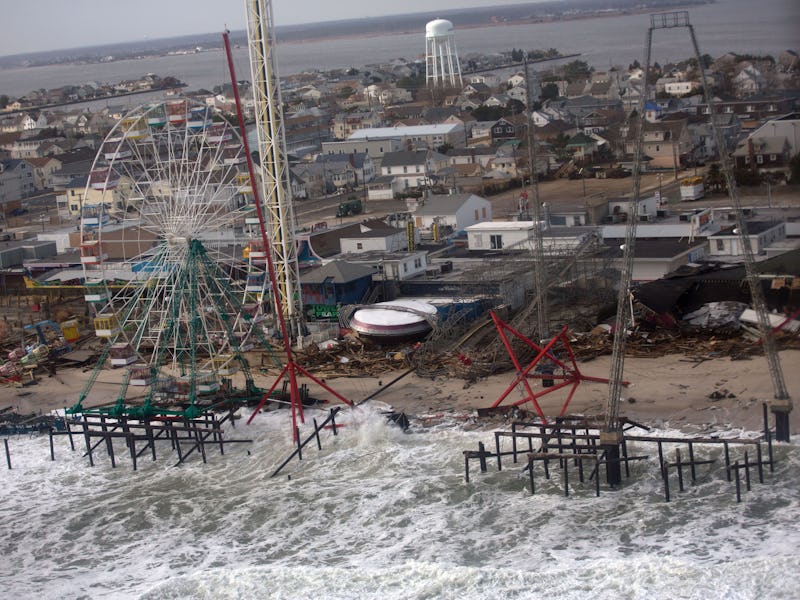How Climate Hacking Could Actually Just Screw Over Life on Earth
Experts weigh in on the pros and cons of geoengineering.

If humans don’t do something soon, climate change is going to be the harbinger of disasters we’ve only so far glimpsed in movies starring Dwayne “The Rock” Johnson. Terrible droughts, heat waves, floods fueled by sea level rise — that’s the shit that will doom us all. Because humans aren’t doing such a great job at cutting the atmosphere’s C02 levels, scientists have begun to explore more radical solutions like geoengineering Earth’s natural systems through technology.
But while a growing number of universities and institutions are exploring the potential of climate hacking to mitigate climate change and perhaps even reverse ongoing trends, other researchers are warning that geoengineering may be a Pandora’s box we ought to keep closed. In a paper published Monday in Ecology & Evolution a team of scientists explain that at least one form of geoengineering has the potential to create a terrible ripple effect if its use was ever halted — meaning that, if we tried it out and then quit, the severe global impact would be worse than if we had never employed it.
The scientists unpack this lesson through an examination of one form of solar engineering, where humans spray sulfur dioxide into the planet’s upper atmosphere to create a cloud that reflect’s solar radiation and helps cool down the planet. Modified airplanes and balloons would have to continuously fly into the upper atmosphere and spray out the chemical compound — essentially a legal and conspiracy-less version of chemtrails. This technology, which the paper’s authors say could be developed within two decades, mimics the atmospheric cooling effect that happens when a large volcano erupts.
Climate change is driving the likelihood of drought and a longer wildfire season.
To study what would happen if we stopped spraying sulfur dioxide into the stratosphere, the researchers developed a computer model that played out a scenario where geoengineers added five million tons of the chemical compound into the air every year for fifty years. This amount of spraying would cause an even distribution of sulfuric acid clouds in the Northern and Southern hemispheres and would lower the global temperature by one degree Celsius.
And that’s what we want right? Lowering the global temperature feels like it should be a good thing: Scientists say that if Earth warms up 2 degrees Celsius beyond pre-Industrial Revolution levels, then the planet crosses a threshold of irreversible damage.
But according to the model, if for some reason sulfur dioxide spraying had to stop, things could get very, very bad. Global rapid warming would occur 10 times faster if the technology had never been used. Both land and ocean temperatures would rise with unprecedented speeds, putting many species of plant and animal life in precarious situations. It’s likely that many flora and fauna would not be able to adapt to this transition, leading to massive and rapid population die-offs.
Climate change has caused the glaciers in the Himalaya Mountains of Bhutan to recede.
“Rapid warming after stopping geoengineering would be a huge threat to the natural environment and biodiversity,” study co-author Alan Robock, Ph.D., an environmental science professor at Rutgers University, explained in a statement released Monday. “If geoengineering ever stopped abruptly, it would be devastating, so you would have to be sure that it could be stopped gradually, and its easy to think of scenarios that would prevent that. Imagine large droughts or floods around the world that could be blamed on geoengineering, and demands that it stops. Can we ever risk that?”
That’s the literal million-dollar question on scientists’ minds, as other researchers explore the possible applications of other geoengineering techniques, including ocean fertilization and ambient air capture. In March, Harvard scientists launched the largest study to date on geoengineering, a plan that includes shooting small amounts of newly created aerosols into the atmosphere by 2022 to test whether they can reduce or reverse ozone loss. The Carnegie Council has launched a long-term geoengineering initiative as well, which it states doesn’t exist to say whether geoengineering is good or bad, but to explore what would happen if it simply existed.
Before geoengineering can even be realistically considered, climatologists and Earth scientists still advocate doing everything we can to reduce greenhouse gas emissions and giving the Earth a chance to stabilize itself from an increasing temperatures and exacerbated weather patterns. Given how risky climate hacking looks to be, that seems to be the best plan to move forward with.
If you liked this article, check out this video where Bill Nye predicts the future!